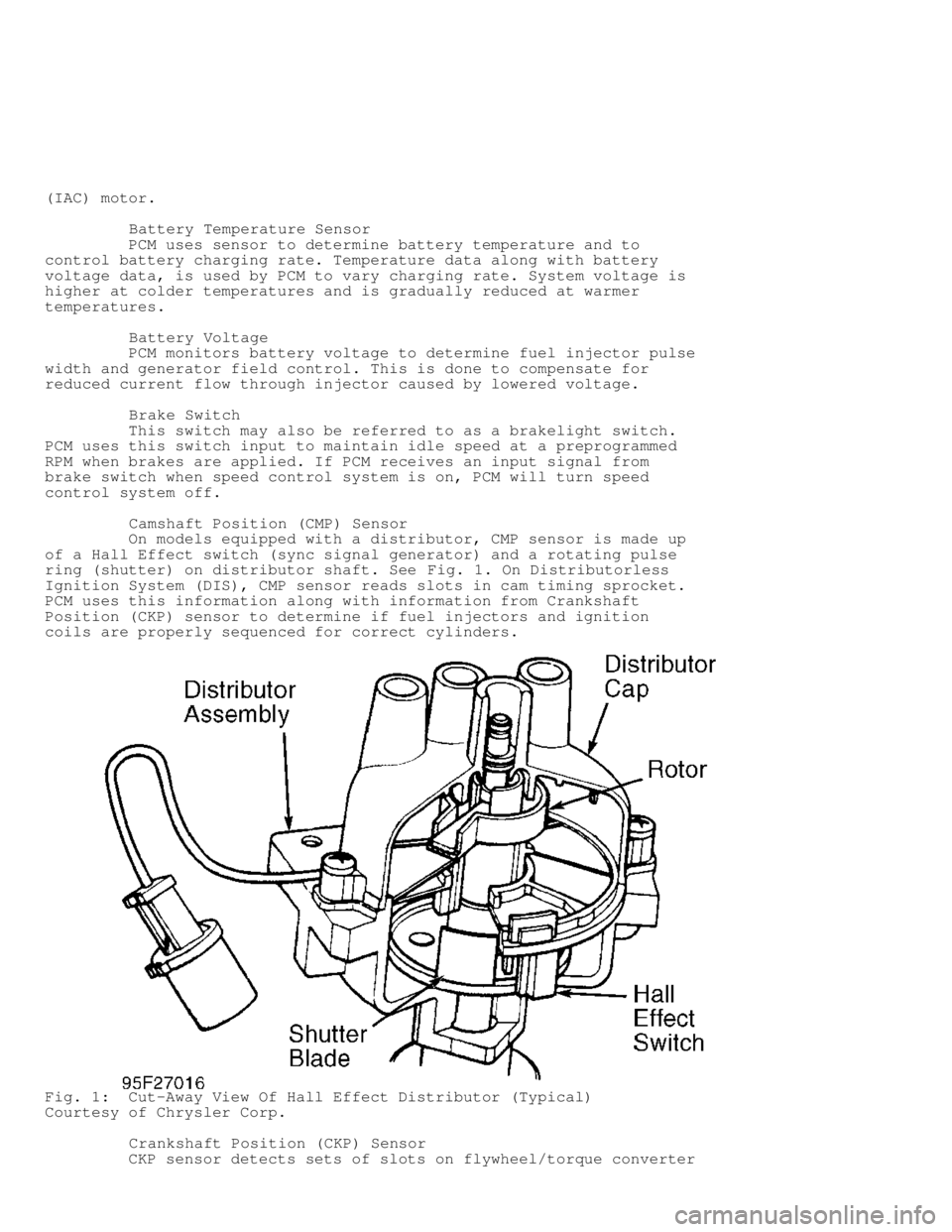1999 DODGE RAM turn signal
[x] Cancel search: turn signalPage 1476 of 1691

(IAC) motor.
Battery Temperature Sensor
PCM uses sensor to determine battery temperature and to
control battery charging rate. Temperature data along with battery
voltage data, is used by PCM to vary charging rate. System voltage is
higher at colder temperatures and is gradually reduced at warmer
temperatures.
Battery Voltage
PCM monitors battery voltage to determine fuel injector pulse
width and generator field control. This is done to compensate for
reduced current flow through injector caused by lowered voltage.
Brake Switch
This switch may also be referred to as a brakelight switch.
PCM uses this switch input to maintain idle speed at a preprogrammed
RPM when brakes are applied. If PCM receives an input signal from
brake switch when speed control system is on, PCM will turn speed
control system off.
Camshaft Position (CMP) Sensor
On models equipped with a distributor, CMP sensor is made up
of a Hall Effect switch (sync signal generator) and a rotating pulse
ring (shutter) on distributor shaft. See Fig. 1. On Distributorless
Ignition System (DIS), CMP sensor reads slots in cam timing sprocket.
PCM uses this information along with information from Crankshaft
Position (CKP) sensor to determine if fuel injectors and ignition
coils are properly sequenced for correct cylinders.
Fig. 1: Cut-Away View Of Hall Effect Distributor (Typical)
Courtesy of Chrysler Corp.
Crankshaft Position (CKP) Sensor
CKP sensor detects sets of slots on flywheel/torque converter
Page 1482 of 1691

operating. When ground is supplied to injector by PCM, armature and
pintle inside injector move a short distance against spring and open a
small orifice. Since fuel is under high pressure, a fine spray is
developed.
Modes Of Operation
As input signals to PCM change, PCM adjusts its response to
output devices. Modes of operation come in 2 types, open loop and
closed loop. In open loop mode, PCM is not using input from HO2S and
is responding to preset programming to determine injector pulse width
and ignition timing. In closed loop mode, PCM adjusts ignition timing
and uses input from HO2S to fine tune injector pulse width.
The following inputs may be used to determine PCM mode:
* A/C Control Positions
* A/C Switch
* Battery Voltage
* Brake Switch
* Camshaft Position (CMP) Sensor
* Crankshaft Position (CKP) Sensor
* Engine Coolant Temperature (ECT) Sensor
* Engine Speed (RPM)
* Heated Oxygen Sensor (HO2S)
* Intake Air Temperature (IAT) Sensor
* Manifold Absolute Pressure (MAP) Sensor
* Park/Neutral (P/N) Switch
* Starter Relay
* Throttle Position (TP) Sensor
* Vehicle Speed Sensor (VSS)
From these inputs, PCM determines which mode vehicle is in
and responds appropriately. Not all inputs are used in all modes or by
all models. Modes of operation are:
* Ignition Switch On (Engine Not Running) - This is an open
loop mode. PCM pre-positions IAC motor based on ECT sensor
input. PCM determines atmospheric pressure from MAP sensor
and determines basic fuel strategy. PCM modifies fuel
strategy according to IAT sensor, ECT sensor and TP sensor
inputs. PCM activates ASD relay, which in turn activates fuel
pump for only 2 seconds unless engine is cranked. PCM also
energizes HO2S heater element for approximately 2 seconds
unless engine is cranked.
* Engine Start-Up - This is an open loop mode. When starter is
engaged, PCM receives input from battery voltage, ignition
switch, CKP sensor, CMP sensor, ECT sensor, IAT sensor, MAP
sensor and TP sensor. Based on these inputs, voltage is
applied to fuel injectors with PCM controlling injection
sequence, rate, and pulse width. PCM provides ground for
injectors to fire in proper order.
PCM determines proper ignition timing according to input
received from CKP sensor. If PCM does not receive CKP sensor signal
within 3 seconds after engine begins cranking, fuel injection system
is shut down and a Diagnostic Trouble Code (FTC) is set in PCM memory.\
* Engine Warm-Up - This is an open loop mode. PCM determines
injector pulse width using input information from battery
voltage, CKP sensor, CMP sensor, ECT sensor, IAT sensor, MAP
sensor and TP sensor. PCM also monitors A/C request and P/N
switch (A/T only) for fuel calculation. PCM controls engine
idle speed through IAC motor. PCM controls ignition timing
based on CKP sensor input.
Page 1483 of 1691

PCM also operates A/C compressor clutch (if A/C is requested)\
through A/C clutch relay. When engine reaches operating temperature,
vehicle will go into idle mode and PCM will begin monitoring HO2S
input and go into closed loop operation.
* Idle - When engine is at operating temperature, this is a
closed loop mode. In idle mode, PCM now adds HO2S signal to
array of inputs used in ENGINE WARM-UP mode. PCM maintains
correct air/fuel ratio by adjusting injector pulse width and
ignition timing. PCM also controls A/C clutch operation (if
A/C is requested).
* Cruise - When engine is at operating temperature, this is a
closed loop mode. Using information from A/C switch, battery
voltage, CKP sensor, ECT sensor, IAT sensor, MAP sensor and
CMP sensor. PCM also monitors A/C request and P/N switch (A/T
only), TP sensor and VSS signals for fuel calculation. PCM
monitors HO2S and adjusts air/fuel ratio as needed. PCM
controls engine idle speed through IAC motor. PCM controls
spark advance as necessary.
* Acceleration - This is an open loop mode. When PCM
recognizes an abrupt increase in throttle position or
manifold pressure as a demand for increased engine output, it
increases injector pulse width in response to increased fuel
demand. HO2S signals are ignored.
* Deceleration - This is an open loop mode when engine is at
operating temperature and under deceleration. When PCM
receives inputs signaling a closed throttle and an abrupt
decrease in manifold pressure, it reduces injector pulse
width to lean air/fuel mixture. Under certain RPM and closed
throttle position conditions, HO2S signals are ignored and
PCM cuts off fuel injection until idle speed is reached. PCM
also drives IAC motor for smooth transition to idle mode.
* Wide Open Throttle - This is an open loop mode. When PCM
senses wide open throttle, it grounds fuel injectors in
sequence, it ignores HO2S input and it controls pulse width
to supply a pre-determined amount of additional fuel. PCM
also adjusts spark advance and disengages A/C clutch for
approximately 15 seconds.
* Ignition Switch Off - This is an open loop mode. PCM drives
IAC motor into position in anticipation of next start-up. All
outputs are turned off, no inputs are monitored and PCM shuts
down.
Sequential Fuel Injection (SFI)
Individual, electrically pulsed injectors (one per cylinder)
are located in intake manifold runners. These injectors are next to
intake valves in intake manifold. PCM controls injection timing based
on crankshaft position signal input. PCM regulates air/fuel mixture by
length of time injector stays open (pulse width) based on inputs from
HO2S, ECT sensor, MAP and other sensors.
IDLE SPEED
NOTE: DO NOT attempt to correct a high idle speed condition by
turning factory sealed throttle body throttle plate set
screw. This will not change idle speed of warm engine, but
may cause cold start problems due to restricted airflow.
Idle Air Control (IAC) Motor
IAC motor adjusts idle speed to compensate for engine load
and ambient temperature by adjusting amount of air flowing through by-
pass in back of throttle body. PCM uses ECT sensor, VSS, TP sensor and
Page 1485 of 1691

Crankcase Ventilation (PCV) system, but does not use a vacuum
controlled valve. See POSITIVE CRANKCASE VENTILATION (PCV).
EVAPORATIVE (EVAP) EMISSIONS SYSTEM
This system stores fuel vapors from fuel tank, preventing
vapors from reaching the atmosphere. As fuel evaporates inside fuel
tank, vapors are routed through vent hoses to charcoal canister where
they are stored until engine is started.
Evaporative Canister Purge Control Solenoid (EVAP-CPCS)
Charcoal canister purging is controlled by PCM through an
EVAP-CPCS. During engine warm-up and for a short period after hot
restarts, PCM energizes EVAP-CPCS, interrupting engine vacuum signal
to charcoal canister.
After engine reaches a predetermined operating temperature
and PCM internal timer has expired, PCM will de-energize EVAP-CPCS,
allowing engine vacuum to purge charcoal canister. EVAP-CPCS will also
be de-energized during certain idle conditions so PCM can update fuel
delivery calibration.
POSITIVE CRANKCASE VENTILATION (PCV)
PCV system uses a vacuum operated valve. A closed engine
crankcase breather/filter, with a hose connecting it to air filter
housing, provides source of air for system. Crankcase blow-by gases
are removed from crankcase through PCV valve with manifold vacuum.
These gases are introduced into incoming air/fuel mixture and become
part of the calibrated mixture.
A non-vacuum operated Crankcase Ventilation (CCV) system is
used on some engines, see CRANKCASE VENTILATION (CCV) SYSTEM.
SELF-DIAGNOSTIC SYSTEM
The PCM monitors several different circuits of engine control
system. If a problem is sensed with a monitored circuit, PCM will
store a Diagnostic Trouble Code (FTC) to aid technician in diagnosis
of system. The Malfunction Indicator Light (MIL), or a scan tool can
be used to read DTCs. For additional information, see SELF-DIAGNOSTICS
- JEEP, TRUCKS & RWD VANS article.
MALFUNCTION INDICATOR LIGHT
Malfunction Indicator Light (MIL) comes on and remains on for\
3 seconds as a bulb test each time ignition switch is turned to ON
position. If PCM receives an incorrect signal or receives no signal
from battery voltage input, charging system, ECT sensor, MAP sensor or
TP sensor, MIL will come on. MIL will also come on if certain
emission-related faults exist. This warns driver that PCM is in limp-
in mode and immediate repairs are necessary. See LIMP-IN MODE under
MISCELLANEOUS CONTROLS. MIL can also be used to display Diagnostic
Trouble Codes (DTCs). For additional information, see SELF-DIAGNOSTICS\
- JEEP, TRUCKS & RWD VANS article.
SERIAL COMMUNICATIONS INTERFACE (SCI)
SCI circuit is used by PCM to send data to and receive data
and sensor activation signals from scan tool. Scan tool uses signals
sent on SCI to display fault messages or Diagnostic Trouble Codes
(DTCs), sensor voltages and device states (On/Off). Scan tool uses S\
CI
to send solenoid and switch activation commands to PCM so that devices
and circuits can be tested. SCI is also used to write SRI mileage to
Page 1486 of 1691

PCM.
MISCELLANEOUS CONTROLS
NOTE: Although not strictly considered part of engine performance
system, some controlled devices can adversely affect
driveability if they malfunction.
A/C CLUTCH RELAY
A/C clutch relay is controlled by PCM. When A/C or Defrost
mode is selected and PCM receives A/C request signal from evaporator
switch, PCM will cycle clutch on and off through A/C clutch relay.
When this relay is energized during engine operation, PCM will
determine correct engine idle speed through IAC motor.
When PCM senses low idle speed or wide open throttle through
TP sensor, PCM will de-energize A/C clutch relay, preventing A/C
operation.
AUTO SHUTDOWN (ASD) RELAY & FUEL PUMP RELAY
ASD relay and electric fuel pump relay are energized when
ignition is on. These relays are controlled through PCM by switching a
common ground circuit on and off. Following components are controlled
by ASD and fuel pump relays:
* Electric Fuel Pump
* Fuel Injectors
* Generator Field Winding
* Ignition Coil(s)
* HO2S Heating Element
When ignition switch is turned to RUN position, PCM energizes
ASD relay and electric fuel pump relay which powers these components.
If PCM does not receive a CMP and CKP sensor signal within one second
of engine cranking (start-up), PCM will turn ground circuit off and
de-energize ASD relay.
GENERATOR
Powertrain Control Module (PCM) regulates charging system
voltage.
LIMP-IN MODE
Limp-in mode is the attempt by PCM to compensate for failure
of certain components by substituting information from other sources
so that vehicle can still be operated. If PCM senses incorrect data or
no data at all from MAP sensor, TP sensor, ECT sensor or battery
voltage, system is placed into limp-in mode and Malfunction Indicator
Light (MIL) on instrument panel comes on.
If faulty sensor comes back on line, PCM will resume closed
loop operation. On some vehicles, MIL will remain on until ignition is
shut off and vehicle is restarted. To prevent damage to catalytic
converter, vehicle should NOT be driven for extended periods in limp-
in mode.
RADIATOR FAN RELAY
Electric cooling fan is used only on Dakota. Using
information supplied by A/C signal (if equipped), ECT sensor, and VSS,\
Page 1487 of 1691

PCM controls operation of electric cooling fan. PCM operates fan
through radiator fan relay by grounding or ungrounding relay control
circuit. PCM regulates engine idle speed through IAC motor when fan is
on.
SHIFT INDICATOR LIGHT
PCM provides ground for shift indicator light on models
equipped with manual transmission. Based on engine speed, throttle
position, and vehicle speed, PCM turns shift indicator light on to
advise driver to shift to a higher gear for optimum fuel economy.
SPEED CONTROL SERVO
System is electrically actuated and vacuum operated. Controls
are located on steering wheel. Controls consist of 3 buttons: OFF/ON,
RESUME/ACCEL and SET/DECEL. Speed control servo is controlled by PCM.
System will operate at 35-85 MPH.
TACHOMETER
PCM provides signal to drive tachometer.
TORQUE CONVERTER CLUTCH (TCC) SOLENOID
PCM controls torque converter lock-up through TCC solenoid.
PCM controls lock-up according to various operating conditions.
TRANSMISSION GOVERNOR SOLENOID
PCM controls solenoid to regulate line pressure for shift
control.
TRANSMISSION OVERDRIVE/OVERRIDE (OD/OR) SWITCH INDICATOR
LIGHT
PCM controls indicator light on OD/OR switch on models
equipped with overdrive automatic transmission.
TRANSMISSION OVERDRIVE (OD) SOLENOID
On models equipped with OD transmission, PCM controls 3-4 OD
upshift and downshift through OD solenoid. PCM determines optimum OD
shift scheduling for all operating conditions.